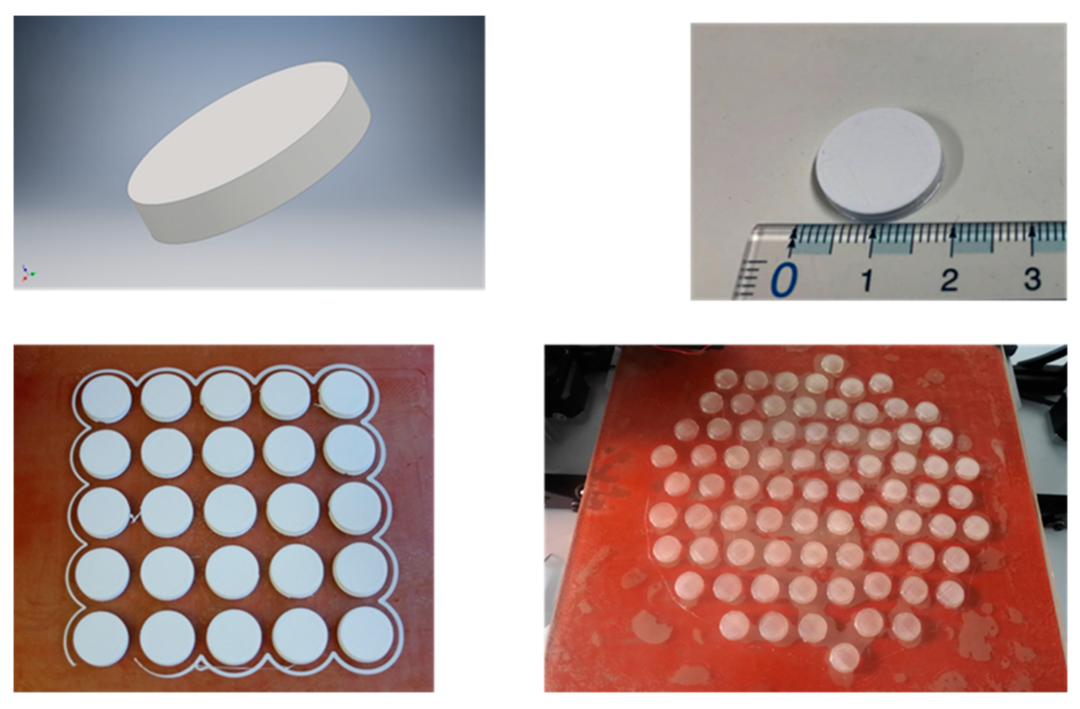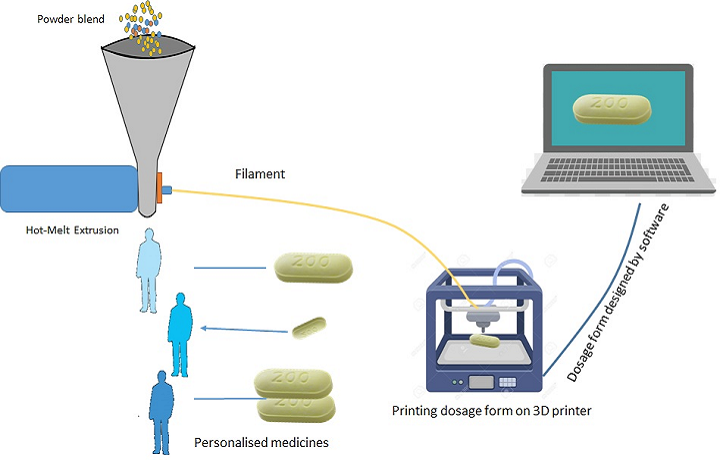International researchers continue to explore the potential of patient-specific treatment via 3D printing, releasing their findings regarding pharmaceuticals in the recently published ‘3D Printing of Pharmaceuticals and Drug Delivery Devices.’
Although greater affordability and accessibility of 3D printers means that the technology is impacting numerous major industries, the strides being made in the medical field are impressive, including medical devices like implants and prosthetics, tissue engineering and a wide variety of different innovations regarding medication and drug delivery. In this review, the researchers discuss current progress in bioprinting, 3D printing applications for drug delivery, and the potential for 3D printing technology as related to pharmaceuticals and medicine in the future.
Extrusion-based Fused Deposition Modeling (FDM) is one of the most used methods of 3D printing due to affordability, good print quality, and the capability for loading drugs into filaments. Implants can be fabricated with a variety of different materials, some of which are biodegradable—and some of which are not. Research teams such as Stewart et al. have also modified implants to include coatings, thus extending release profiles. Others like Giri et al. have created gastro-retentive floating tablets (GRFT), again featuring drug-loaded filaments.

Researchers often use FDM printers, as discussed in ‘Testing Chemical Modifications and In-Vitro Biological Properties in FDM 3D Printing‘ (Image: ‘Fused Deposition Modeling 3D Printing: Test Platforms for Evaluating Post-Fabrication Chemical Modifications and In-Vitro Biological Properties’)
Similiar research, such as studies performed by Azad et al. have centered around the importance of singling out suitable polymers for extrusion-based 3D printing, assessing mechanical properties and success of experimental mixtures.

From Azad et al., Characterizations required for 3D printed structure, drug, and polymer (or other functional excipients, if necessary). From ‘Polymers for Extrusion‐Based 3D Printing of Pharmaceuticals: A Holistic Materials–Process Perspective‘
“They confronted 3DP with the current process of direct compression and evidenced the importance to know the rheological properties of the polymers and polymer–API mixture in order to predict their impact on the printing process and on the final dosage form,” explain the authors. “They also discussed which kind of characterization methods are required for 3D printed structure, drug, polymer and other functional excipients. Finally, examined the challenges and opportunities related to pharmaceutical extrusion-based 3DP.”
Kjar and Huang also investigated various applications related to micro-manufacturing, along with drug delivery. Araújo et al. offered a study based around the concept of pharmacies turned digital, with on-demand fabrication of patient-specific dosages.
“Pharmaceutical companies will need to work in unison with these digital pharmacies for the large-scale production of extruded filaments, which the digital pharmacies can later use to print. The regulatory concerns surrounding 3DP were also evaluated showing that patents have hindered 3DP products from reaching the market and there should be greater cooperation between regulatory and patenting authorities to ensure that 3DP products can reach the market,” said the authors.
Other researchers such as Domínguez-Robles et al. experimented with creating PLA filaments accentuated with natural materials like lignin, while yet others such as Alhijjaj et al. focused on the critical need for improved process parameters in 3D printing of pharmaceuticals, discussing both macroscopic and microstructural reproducibility.
Other typical 3D printing techniques associated with pharmaceuticals include:
- Stereolithography (SLA) – proven effective for fabrication of solid dosage forms, promoting patient-specific medication, and drug-release systems.
- Selective Laser Sintering (SLS) – previous research teams like Awad et al. have successfully manufactured miniprintlets for small dosages, creating samples with paracetamol and ibuprofen.
- Bioprinting – bioprinted scaffolding structures have proven successful in applications like bone regeneration and healing of fractures, as well as bio-inks being created for wound dressings—both direct and indirect.
More alternative forms include digital light processing (DLP), stencil printing, embedded printing (e-3DP), and semi-solid extrusion printing (EXT).

HP’s new bioprinter helps researchers fabricate pharmaceutical samples (Image: HP)
“There is an increasing research using multiple types of 3DP. However, one of the main advantages common to all available types of 3DP is the ability to create personalized medicine. AM, due to its ease of use, speed and accessibility is increasingly promoting the creation of medical devices and pharmaceutical products on demand for patients within a clinical setting,” concluded the authors. “The ability to change the release profile and dosing of a 3D printed tablet simply by changing the geometries using CAD and the ability to incorporate drugs into FDM printed injectable devices or mesh implants using HME, opens up a wide range of possibilities within the application of 3DP in the medical field.
“However, more research does need to be conducted in the field before the production of 3D-printed products on demand can become a reality within a clinical setting, such as the effect of process parameters on the print quality and how reproducibility in 3DP can be improved. FDM is also limited to the number of drugs that can be loaded into filaments, as they need to withstand the high temperatures of the process. However, if research continues to rise in the area of 3DP, due to the versatility of 3D printed products and the number of manufacturing advantages that 3DP offers there is potential for more 3DP to leave the proof of concept stage and be developed into a widely used manufacturing tool.”

Researchers may combine techniques, as discussed in ‘Researchers Combining FDM 3D Printing with Hot-Melt Extrusion for Drug Delivery Systems‘ (Image: “Advanced Pharmaceutical Applications of Hot-Melt Extrusion Coupled with Fused Deposition Modelling (FDM) 3D Printing for Personalised Drug Delivery,”)
What do you think of this news? Let us know your thoughts; join the discussion of this and other 3D printing topics at 3DPrintBoard.com.
[Source: ‘3D Printing of Pharmaceuticals and Drug Delivery Devices’]Subscribe to Our Email Newsletter
Stay up-to-date on all the latest news from the 3D printing industry and receive information and offers from third party vendors.
You May Also Like
Gorilla Sports GE’s First 3D Printed Titanium Cast
How do you help a gorilla with a broken arm? Sounds like the start of a bad joke a zookeeper might tell, but it’s an actual dilemma recently faced by...
Nylon 3D Printed Parts Made More Functional with Coatings & Colors
Parts 3D printed from polyamide (PA, Nylon) 12 using powder bed fusion (PBF) are a mainstay in the additive manufacturing (AM) industry. While post-finishing processes have improved the porosity of...
$25M to Back Sintavia’s Largest Expansion of Metal 3D Printing Capacity Since 2019
Sintavia, the digital manufacturing company specializing in mission-critical parts for strategic sectors, announced a $25 million investment to increase its production capacity, the largest expansion to its operations since 2019....
Velo3D Initiates Public Offering in a Bid to Strengthen Financial Foundations and Drive Future Growth
Velo3D (NYSE: VLD) has been among a number of publicly traded 3D printing firms that have attempted to weather the current macroeconomic climate. After posting a challenging financial report for 2023,...





























